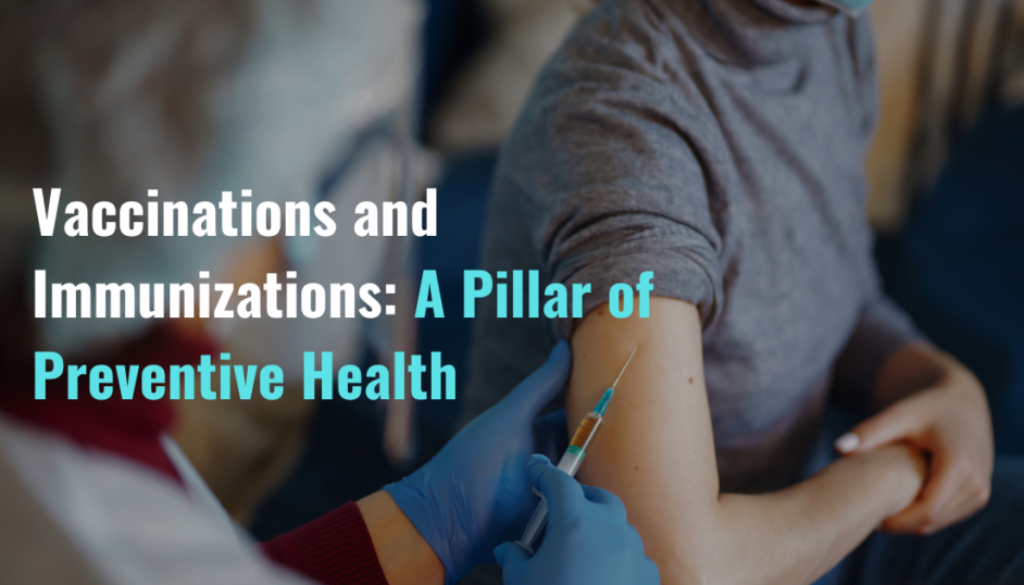Vaccinations and Immunizations: A Pillar of Preventive Health
Muhammad Ahmar Preventive Health 0
Vaccinations and immunizations are a pivotal element of preventative health, guarding individualities and communities from a wide range of contagious conditions. By stimulating the vulnerable system to fete and combat pathogens, vaccines help help illness and save lives. This companion will cover the significance of vaccinations, the types of vaccines, the recommended immunization schedule, and address common enterprises and misconceptions.
Why Vaccinations Matter
Vaccinations are essential for several reasons:
- Disease Prevention: Vaccines help conditions that can beget serious illness, disability, or death.
- Community Impunity: Also known as herd impunity, when a significant portion of a community is vaccinated, the spread of contagious conditions is minimized, guarding those who can not be vaccinated.
- Global Health: Vaccinations have canceled or significantly reduced the prevalence of deadly conditions worldwide.
How Vaccines Work
Vaccines work by mimicking contagious agents, similar as bacteria or contagions, without causing the complaint. This process trains the vulnerable system to fete and fight these pathogens if encountered in the future. Then is a simple breakdown:
- Antigen Exposure: The vaccine introduces a inoffensive part of the pathogen( antigen) to the body.
- Immune Response: The vulnerable system recognizes the antigen as foreign and produces antibodies to fight it.
- Memory Cells: The vulnerable system creates memory cells that flash back the pathogen.However, the body can snappily produce the right antibodies to fight it off, If exposed to the factual complaint latterly.
Humor moment: Think of vaccines as a dress trial for your vulnerable system. By the time the real show comes, your vulnerable system knows all its lines!
Types of Vaccines
There are several types of vaccines, each designed to combat specific conditions:
- Live-minimized Antibodies: These contain debilitated exhibitions of the living virus or microorganisms. representations incorporate the measles, mumps, and rubella (MMR) immunization and the chickenpox antibody.
- Inactivated Antibodies: These contain dispensed with disease or microorganisms. embodiments incorporate the polio immunization and the hepatitis An immunization.
- Subunit, Recombinant, and Form: Immunizations These utilization bits of the microorganism( like protein or sugar) to deliver a weak reaction. embodiments incorporate the HPV antibody and the hepatitis B immunization.
- Pathogen Antibodies: These contain harms created by the microorganisms that have been made tame. epitomes incorporate the diphtheria and lockjaw antibodies.
- mRNA Immunizations: These give the inheritable directions for cells to deliver a protein that sets off a weak reaction. epitomes incorporate some Coronavirus antibodies.
Suggested Vaccination Timetable
Vaccination plans are intended to give exemption at the ideal times during an individual’s life. These timetables are laid out by wellbeing specialists like the Communities for Infectious prevention and Avoidance( CDC) and the World Wellbeing Association( WHO). Then’s a general figure
For babies and Children
- Hepatitis B: Given upon entering the world, 1-2 months, and 6- 18 months.
- DTaP (Diphtheria, Lockjaw, Pertussis): Given at 2, 4, 6 months,15- 18 months, and 4- 6 times.
- MMR( Measles, Mumps, Rubella): Given at 12- 15 months and 4- 6 times.
- Varicella( Chickenpox): Given at 12- 15 months and 4- 6 times.
- Polio( IPV): Given at 2, 4 months, 6- 18 months, and 4- 6 times.
For Adolescents
- HPV (Human Papillomavirus): Given at 11- 12 years (can be started as beforehand as 9 year), with a alternate cure 6- 12 months latterly.
- Tdap (Tetanus, Diphtheria, Pertussis): Given at 11- 12 years.
- Meningococcal: Given at 11- 12 years with a supporter at 16 years.
For Adults
- Influenza: Annual vaccination.
- Tdap/ Td: supporter every 10 years.
- Shingles (Herpes Zoster): Recommended for grown-ups 50 years and aged.
- Pneumococcal: Recommended for adults 65 years and aged, or youngish with certain health conditions.
For Seniors
- Influenza: Annual vaccination, especially important for aged grown-ups.
- Shingles: Two boluses of the Shingrix vaccine for grown-ups 50 years and aged.
- Pneumococcal: Two types of pneumococcal vaccines( PCV13 and PPSV23) are recommended for grown-ups 65 years and aged.
Addressing Common Concerns and Misconceptions
Despite the inviting benefits of vaccines, some people still have enterprises. Let’s address some common myths:
Myth 1: Vaccines Beget Autism
This myth began from a now- discredited study. expansive exploration has shown no link between vaccines and autism.
Myth 2: Natural Impunity is More
While natural infection can give impunity, it also comes with the threat of severe illness or death. Vaccines give impunity without these pitfalls.
Myth 3: Vaccines Contain Dangerous Constituents
Vaccines contain constituents in veritably small quantities to insure safety and effectiveness. These constituents are strictly tested and covered by health authorities.
Myth 4: Vaccines Are Not Necessary Because Disease Rates Are Low
Low complaint rates are a result of high vaccination rates. Stopping vaccinations would lead to a rejuvenescence of these conditions.
Humor moment: Skipping vaccines because complaint rates are low is like refusing to wear a mac because you do not see any shadows. More safe than sorry!
Benefits of Vaccinations Beyond Disease Prevention
Vaccinations offer benefits that extend beyond individual complaint forestallment:
- Economic Savings: Precluding conditions reduces healthcare costs associated with treatment and hospitalization.
- Diminished Anti-microbial: Opposition Immunizations can help bacterial contaminations, decreasing the requirement for anti-toxins and decelerating the spread of anti-toxin obstruction.
- Monitoring Weak Population: Antibodies cover the people who can not be immunized, comparable as children, pregnant ladies, and immunocompromised singularities.
The part of Community and Global Vaccination Efforts
Vaccination sweats extend beyond individual health, playing a vital part in community and global health. Then’s how:
Community Impunity
At the point when a huge piece of the populace is immunized, the spread of infectious circumstances is limited. This safeguards the individuals who can not be immunized because of ailments.
Global Health Initiatives
Vaccination programs worldwide have led to the eradication of smallpox and significant reductions in conditions like polio and measles. Continued global sweats are essential to control and exclude other contagious conditions.
Staying Informed and Up- to- Date
Keeping up with vaccinations is a lifelong process. Then are some tips to stay on track:
- Consult Your Healthcare Provider: Regular check- ups and conversations with your healthcare provider will help you stay informed about the vaccines you need.
- Keep Records: Maintain a vaccination record for yourself and your family members.
- Use Reminders: Set monuments for forthcoming vaccinations using your phone or a timetable.
- Educate Yourself: Stay informed about the rearmost vaccine recommendations and updates from dependable sources like the CDC and WHO.
Conclusion
Vaccinations and immunizations are a abecedarian aspect of preventative health, guarding individualities and communities from contagious conditions. By following recommended immunization schedules and staying informed, you can contribute to a healthier, safer world.
Flash back, an ounce of forestallment is worth a pound of cure. So, roll up your sleeves, get vaccinated, and be a part of the global trouble to help complaint and promote health. And do not forget, vaccines are n’t just for kiddies grown-ups need them too!
Stay healthy, stay informed, and keep laughing along the way. Your future tone will thank you.



